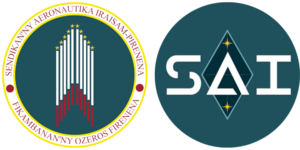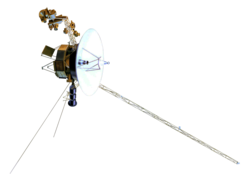International Aeronautical Union
Sendikan'ny Aeronautika Iraisam-Pirenena (Nylele) | |
 Seal & Insignia of the IAU | |
 | |
| Abbreviation | SAIP |
|---|---|
| Formation | January 31, 1970 |
| Headquarters | Congvat, Daobac |
Official language | Nylele |
Administrator | Chief Administrator XXX |
Parent organisation | |
Budget | |
Staff | TBD |
The International Aeronautical Union (Nylele: Sendikan'ny Aeronautika Iraisam-Pirenena (SAI), commonly abbreviated as the IAU, is an independent agency of the Association of Ozeros Nations (AON) that is responsible for pioneering and coordinating the activities of its member states civilian space program. The IAU was founded in 1970, is headquartered in Congvat and has a permanent staff of XXXX people. Member states of the AON contribute to the IAU in various ways. Some contribute solely by providing funding for the organization, others provide various facilities related to the study of space exploration such as launch, and vehicle manufacturing facilities, observatories and research labs. Others nations who do not have much in the way of extra funds for government spending, contribute by providing land that is suitable for IAU sponsored launch service providers to lease, construct and operate launch or research facilities in their countries. The IAU's primary launch vehicles include the Phoenix 1 MLV and Phoenix 2 HLV rockets, both of which were designed by the Daobac Space Corporation as well as manufactured and funded by its various partners both within the IAU and the Joint Space Agency. The IAU also utilizes the XXX, XXX and XXX launch vehicles from XXX, XXX and XXX. The establishment of the IAU has had a positive contribution for member states that both have and do not have launch capability. For those that have launch capability, no single nation or organizaiton is capable of drumming the funding, political will nor public support for large scale and long term projects. The presence of the IAU allows its member states to tap into a larger pool of resources, of which both expertise and cost can be shared among one another. For states that do not have launch capability they are now able to more easily have and request access to launch their own satellites from member states that do have that capability. All member states are also able to utilize IAU sponsored research facilities for academic and development purposes such as observatories, research laboratories and manufacturing facilities.
History
Establishment
During its formative years the member states of the AON had no body or institution that was dedicated to furthering the exploration of space. The exploration and research of space as well as the development of space exploration technologies were left entirely to each individual member state to pursue. While the more wealthier countries were able to fund and initiate their own indigenous space agencies, less wealthier member states were unable to do so, or had difficulty in gaining access to such technologies and capabilities. In 1969 negotiations began among the AON's member states to establish an organ of the AON to help coordinate and foster space exploration and research amongst its member states. These negotiations eventually culminated in the Treaty XXX which established the IAU as an independent agency of the AON. While the treaty was unanimously signed between by the delegations within the AON, not all member states immediately ratified it. It was not until 1980 when all member states of the AON had ratified the treaty.
Early Years
Contemporary Era
Management
Structure
The IAU charter is the founding document upon which the agency was established and fills a role similar to that of a constitution. The headquarters of the IAU is located in Congvat, the capital city of Daobac. Its most senior leadership body is called the Officer of the Administrator and is led by the Chief Administrator of the IAU is the highest level decision maker within the IAU, equivalent to a chief executive officer, implement's the agency's mission & vision and is responsible for the overall management and administration of the IAU. A group of Administrators assists the Chief Administrator, each of whom are responsible for managing the day to day operations of a certain directorate, or is responsible for key programs of the IAU. While the Office of the Administrator is responsible for the day-to-day administration and operation of the IAU, a separate independent body called the Executive Council provides oversight and sets the strategic long term mission of the agency. Members of the Executive Council are referred to as 'councilors', with each member state allocated one councilor that they are able to nominate into the organ.
Organization
The IAU is comprised of XXX primary "directorates" which are as follows:
- Administration & Legal: the duties of the Administration & Legal directorate includes the approval of programs and initiatives from all other directorates within the IAU and also to provide legal counsel of AON laws when required. It also serves as the agency's internal audit board, regularly conducting audits of the various directorates and programs of the IAU to ensure all abide by IAU and AON standards and laws.
- Finance & Treasury: The stewards of the IAU's funding. The Finance & Treasury directorate manages and distributes all funding the IAU receives from its member states. It ensures that the agency's short, medium and long term expenditures and investments are implemented in a sustainable manner.
- Operations:
- Human Resources & General Affairs: The Human Resources & General Affairs (HRGA) directorate is responsible for the recruitment & well being of employees in the IAU, the procurement of resources for the IAU and the management of IAU assets.
- Communications & Advocacy:
Membership
The IAU is comprised of the ten space agencies of the Association of Ozeros Nations member states, though membership is not compulsory and like the AON itself, the IAU does not restrict its members from participating in other intergovernmental organizations related to the field of space exploration. The organization additionally includes Zacapican, a non-AON state, as part of the bi-national MTC agency serving as the space agency for Pulacan and party to the IAU. Members of the IAU are required to contribute to the organization, though what form this contribution would take is not restricted in the form of funding. Instead members of the IAU may provide contribution that are non-monetary in nature, such as: launch & research facilities, viable land where either launch or research facilities for the IAU could be built on, manpower and manufacturing facilities. This flexible contribution program has allowed member states, who had little to no financial resources to provide funding, to join and provide otherwise untapped resources for the IAU. Direct funding is generally provided by the IAU's more wealthier states, whereas others such as Ankat might provide land and manpower for the IAU. Major launch facilities and systems are provided by Daobac, Kajera, M'biruna, Pulacan and Pulau Keramat.
| Member State | AON Membership | Membership Status | National Program | IAU Accession | Contribution | |||
|---|---|---|---|---|---|---|---|---|
| Funding | Launch Vehicle | Facilities | Others | |||||
| Yes | Full | n/a | TBD | o | x | o | o | |
| Yes | Full | Daobac Space Corporation | 31 January 1970 | o | o | o | o | |
| Yes | Full | TBD | TBD | tbd | tbd | tbd | tbd | |
| Yes | Full | TBD | TBD | o | o | o | o | |
| Yes | Full | TBD | TBD | x | x | o | o | |
| Yes | Full | TBD | TBD | tbd | tbd | tbd | tbd | |
| Yes | Full | United Space Exploration Authority | TBD | o | o | o | o | |
| Yes | Full | TBD | TBD | o | o | o | o | |
| Yes | Full | TBD | TBD | tbd | tbd | tbd | tbd | |
| No | Full | United Space Exploration Authority | TBD | o | o | o | o | |
| Yes | Full | TBD | TBD | tbd | tbd | tbd | tbd | |
Programs
Active
Explorer Program
The Explorer Program is an ongoing scientific and space exploration program of the IAU that utilizes a variety of space probes that travels thorugh space and collect scientific data. The Explorer Program is the IAU's longest active program, having been in operation since 1986 and is considered as one of its most best and well known scientific programs. Explorer probes have been sent to explore Ajax's moon, as well as both the inner and outer planets of the Solar System. The first Explorer probe, Explorer 1, was launched in July 1986 on board a Dragon 3 rocket and is widely considered to be a test run of the Explorer probes in general. Throughout its mission window from July to October, the Explorer 1 probe measured various phenomenas such as magnetic fields, solar flare particles and ionization of the interplanetary region. Its success prompted the IAU to provide further funding and in the next four years, the Explorer 2, 3, 4, 5 and 7 probes were launched as a series of space weather stations that monitors and observes solar wind, cosmic rays and magnetic fields. Its most successful and famous probes however are the Explorer 10 and 11 probes. These two probes were launched to take advantage of a favorable alignment of the outer planets which allowed the probes to visit all the gas giants beyond the asteroid belt and send data back to AJax. Explorer 10 was launched on the 7th of April 1997 and Explorer 11 followed one month later on May 1997. To date, the Explorer 10 is the furthest man made object sent into outer space, with Explorer 11 following close behind it. In the modern era, the Explorer program is centered around the exploration of the inner planets for evidence that some of the inner planets may have supported life in the past. Its most recent project is the Mars Explorer space probe which sent a rover, the Inquiry rover, to land on the surface of mars and conduct various scientific experiments on the surface, while the Mars Explorer probe continued to gather data of Mars from orbit.
Dragonfly Program
The Dragonfly Program is the IAU's primary spaceplane used to routinely shuttle both crew and cargo to and from space. Having been in service since 1982 the Dragonfly Program has flewn XXX missions and carried XXX astronauts from XX countries throughout its lifetime. The Dragonfly is composed of an orbiter unit that is launched by the TH Meyyotl super heavy-lift launch vehicle which was powered by four boosters attached to a primary central core powered by four engines. It could carry up to 10 astronauts and up to 30,000 kg (66,000 lb) of payload into low ajax orbit (LAO).
Insight Program
Insight is
Compass Program
Compass is the IAU's global navigation satellite system that was first deployed and went live in 1990.
Vĩnh Ngọc Lan Program
The Vĩnh Ngọc Lan program, named after the renowned astronomer and mathematician Vĩnh Ngọc Lan, is the IAU's active program space telescope that began in 2020.
Retired
Collaboration with other agencies
Joint Space Agency
Hardware
Launch System
Spacecraft
| Name | Type | Max Crew | Manufacturer | Max Payload (kg) | Status | Date of flight | |
|---|---|---|---|---|---|---|---|
| First | Latest | ||||||
| Dragonfly | Cargo & Manned | 10 | 30,000 | Operational | 1985 | 2023 | |
| Unicorn 2-CR | Cargo | None | 6,000 | Operational | 2018 | 2023 | |
| Unicorn 2-CW | Manned | 4 | 6,000 | Operational | 2018 | 2023 | |
